USNS Mission San Juan (T-AO-126)
 | |
| History | |
|---|---|
| Name: | Mission San Juan |
| Builder: | Marinship Corporation, Sausalito, California |
| Laid down: | 30 July 1943 |
| Launched: | 14 October 1943 |
| Commissioned: | 31 January 1944 |
| Decommissioned: | Unknown |
| Fate: | Sold for scrapping, 1975 |
| General characteristics | |
| Class and type: | Mission Buenaventura-class oiler |
| Displacement: |
|
| Length: | 523 ft 6 in (159.56 m) |
| Beam: | 68 ft (21 m) |
| Draft: | 30 ft (9.1 m) |
| Propulsion: | Turbo-electric, single screw, 6,000 hp (4.47 MW) |
| Speed: | 14 knots (26 km/h; 16 mph) |
| Complement: |
|
| Armament: |
|
SS Mission San Juan was a Type T2-SE-A2 tanker built for the United States Maritime Commission during World War II. After the war she was acquired by the United States Navy as USS Mission San Juan. Later the tanker transferred to the Military Sea Transportation Service as USNS Mission San Juan. She was a member of the Mission Buenaventura-class oiler and was named for Mission San Juan Bautista in San Juan Bautista, California.
Service history
As oiler, 1943–1958
Mission San Juan was laid down on 30 July 1943 under a Maritime Commission contract by Marine Ship Corporation, Sausalito, California; launched on 14 October 1943, sponsored by Mrs. Derrill D. Standifird; and delivered to the Maritime Commission on 31 January 1944 upon completion. Chartered to Deconhill Shipping Company in February, 1944 the tanker spent the remainder of the war supplying fuel oil to American and Allied Forces overseas, during which time she was awarded the National Defense Service Medal.
Shortly after the cessation of hostilities, Mission San Juan was placed in the Maritime Commission Reserve Fleet at Mobile, Alabama on 9 April 1946. Acquired by the Navy on 21 November 1947 she was retransferred to the Naval Transportation Service the same date. Designated as Mission San Juan (AO-126), she served as such until 1 October 1949 when the newly formed Military Sea Transportation Service took over the functions and ships of the Naval and Army Transportation Services. Acquired by MSTS on 1 October, she was designated USNS Mission San Juan (T-AO-126) and was placed in service with a civilian crew. During the Korean War, she carried fuel to the forward operating bases and continued in this duty until after the war, until 12 February 1958 when she was placed out of service by MSTS, stricken from the Naval Vessel Register and transferred on the same date to the Maritime Administration and laid up in the Reserve Fleet at Beaumont, Texas.
As tracking ship, 1964–1970
Reacquired by the Navy on 28 October 1964, Mission San Juan was moved to the General Dynamics Shipyard, Quincy, Massachusetts, for conversion into a missile range instrumentation ship. During this conversion, she was jumboized by fitting a new 72-foot section amidships and virtually rebuilt in order to accommodate the required electronic equipment. Renamed Flagstaff and designated AGM-21 on 8 April 1965, she was again renamed, on 1 September 1965, to Mercury.
Accepted by MSTS for service on 16 September 1965, she was designated as USNS Mercury (T-AGM-21) and assigned to MSTS Atlantic for duty. During the Project Gemini series of orbits, she served as an important link between the astronauts and the control stations at Cape Canaveral. She carried out this duty until the summer of 1967 when she returned to the yard at Quincy for the installation of satellite terminals.
Upon completion of this installation on 18 September 1967, she was reassigned to MSTS, Atlantic, but shortly thereafter was reassigned to MSTS, Pacific. There she was to play an important part in the Project Apollo moon shot tests as she provided important communication links between the Apollo moon craft and earth tracking stations.
As bulk-carrier, 1970–1984
The ship was sold on 23 June 1970 to Matson Navigation Co. for conversion to a bulk-carrier at the Willamette Iron and Steel Works, Portland, Oregon, and renamed SS Kopaa. Sold in February 1981 to California & Hawaii Sugar Co., she was sold for scrapping at Taiwan in October 1984.
References
- This article incorporates text from the public domain Dictionary of American Naval Fighting Ships. The entry can be found here.
- "T-AO-126 Mission San Juan / T-AGM-21 Flagstaff / T-AGM-21 Mercury". Fleet Oiler (AO) Photo Index. Retrieved March 31, 2006.